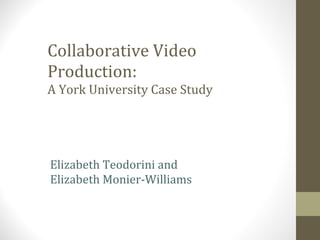How to make compelling video
- 1. Collaborative Video Production: A York University Case Study Elizabeth Teodorini and Elizabeth Monier-Williams
- 3. Planning: Content Clarify ¡ª in one sentence ¡ª the single message you want to communicate. Adapt your content ¡ª make it relevant to your user . Keep it short! One to five minutes. How to Make Your Garden Bee Friendly explains the benefits of bee-friendly plants and gives practical suggestions for attracting bees. It also promotes Professor Packer, his book and research at York University.
- 4. Planning: Your Subject Pre-interview your speaker. Get a feel for your speaker¡¯s style and presence. If he or she is not strong on screen, you¡¯ll need more editing to deliver longer sections and more b-roll. Discuss the single message. Does it make sense to the speaker? Body language will make it clear if he or she is uncomfortable.
- 5. Planning: The Outline Working from an outline, and using it to prompt your speaker with questions during the shoot, results in a more natural product than scripting. How to Make Your Garden Bee Friendly Why bees are important to human survival (food) Bees are in trouble (population, pollution, illness, etc.) Bee-friendly plants and ¡°houses¡± Interesting facts (all sizes, not furry, not wasps, etc.) Resources (URLs, book)
- 6. Planning: Videography Consult Perfect world: Your crew are media specialists and adjust equipment choices and shot composition to meet your needs. Luckily, we have in-house access to that perfect world: We corresponded with Bob McKenize and Rob Denault in York¡¯s Learning Technology Services group. Involving them from the beginning ensured that web, social media and other technical and stylistic considerations were fully integrated.
- 7. Planning: Videography Consult Your videographer wants to know: Audience Video outline ¡ª what footage do you need? Timeline for post-production Distribution and deliverables (file types, inclusion of graphics, music requirements, etc.) Tone and styling (documentary style, transitions or hard cuts, fonts, name key style, etc.) Location details (light sources, power sources, etc.) Ask for input throughout the process.
- 8. Planning: Equipment Details Camera : HD DSLR with choices of lenses and filters Audio : Boom microphone with double-system audio workflow Lighting : Outdoor light, but the kit included a two-sided reflector as an option Crew : Two media integration specialists shooting video, audio and high-res stills
- 9. Planning: Location Consider doing a pre-shoot visit with your videographer to troubleshoot issues like lighting and sound. Professor Packer told us we needed a sunny day to ensure the bees would be out.
- 10. The Shoot Work from your outline and b-roll list. Work closely with your videographer. Keep your subject¡¯s energy up. Take breaks and provide water/snacks. We started in the garden¡¯s east end to keep direct sun and ensure consistent lighting.
- 11. The Shoot When prompting your speaker, ensure he or she sets up the response. You: ¡°What kinds of plants attract bees?¡± Speaker: ¡°The kinds of plants that will attract bees to your garden are x, y and z.¡± NOT: ¡°x, y and z,¡± which will be out of context after editing. We encouraged Professor Packer to address ¡°you¡± rather than referring more generically to ¡°people,¡± and to treat the camera like a person.
- 12. Post-Production ~3 rounds Sites like Vimeo save time when you have multiple reviewers and provide a clear editorial record. Get someone with no content knowledge to watch it for gaps.
- 13. Post-Production Be flexible: Your speaker may touch on something unplanned that you want to include with more detail. Something you thought would work could flop. The content order may change if a more natural segue emerges in the footage. We introduced the freeze frames or ¡°cards¡± to add clarity to the content.
- 14. Communications Rollout Know your audience and forum: Event presentation Website Social Media: Facebook, Twitter, youtube, etc. SEO Caption your video (accessibility) Use content tags Pick a strong title ¡ª it¡¯s central to your social media content Try a Google search to see where the video ranks
- 15. Our Communications Rollout Fall 2010: Alumni Matters, Alumni website, youtube channel, Facebook post Research news website, @YUResearch, targeted messages (e.g., funders, book publicist, etc.) VPUR: media relations, Y-file, faculty and department pages, etc. Spring 2011: Gardening, urban space and environment magazines, blogs and organizations Second push through Alumni Matters
- 16. Resources Staff Resources (spread over several weeks): Planning ¡ª 2 days Shoot ¡ª ? day Post-production ¡ª 1 day Rollout: ? day Film Crew Cost: ~$950 $525 shoot $425 post-production
- 17. Lessons Learned: Location Shooting outdoors subjects you to weather, but can produce exceptional footage. Have a back-up plan. Consider noise sources when scouting locations. Listen to your crew. We had nearby construction and planes flying overhead so we had to wait for noise gaps to film some sections. Our crew was confident the audio would be fine, so we didn¡¯t have to move inside.
- 18. Lessons Learned: Collaboration Teams are more powerful than individuals: Sharing costs and resources makes video production more manageable More expertise = stronger product More connections mean wider distribution networks and better exposure Better content = better reach = ¡ü views
- 19. Recommendations Don¡¯t script. Prompt . Work to your speaker¡¯s strengths . Not everyone is a performer. Use b-roll and editing to fill the gaps. That means you must plan ahead .
- 20. Recommendations Invest in training for staff and faculty who will regularly appear on camera or produce video. Use simple, standardized styling that emphasizes the institution, not internal organizational structures. Thank you




















